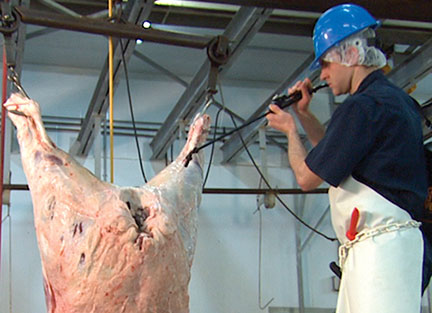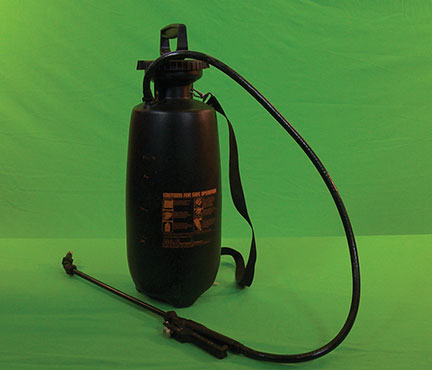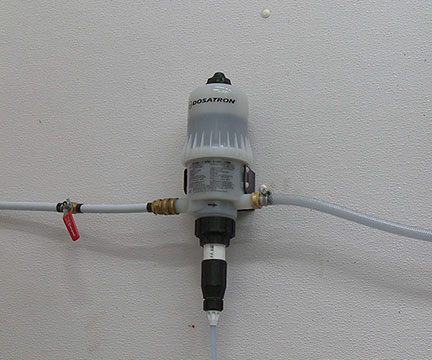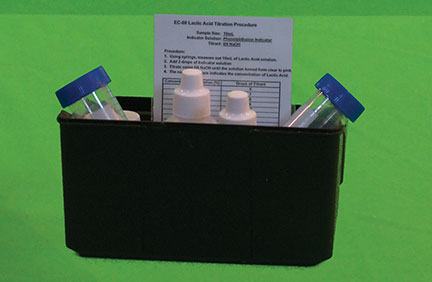| |
Antimicrobial Spray Treatment of Red Meat in Small Abattoirs | |
| |
|
|
| |
|
|
| | What is antimicrobial spray treatment? | Benefits of antimicrobial spray | Key food safety steps during slaughter | Monitoring/records requirement
Operators work hard to produce safe and wholesome meat products.
Operators can take steps to improve food safety and wholesomeness. One of these key steps is the use of an antimicrobial spray treatment of red meat carcasses.
What is Antimicrobial Spray Treatment?
Antimicrobial spraying is approved by Health Canada as a processing aid to control harmful bacteria on meat surfaces post slaughter. A dilute antimicrobial solution is sprayed on carcasses, internal organs and meat parts.
Organic acids (lactic, acetic and citric), peroxyacetic acid and chlorine-based compounds such as sodium hypochlorite are commonly used:
- In small abattoirs, solution is usually applied with a garden sprayer or automatic pump.
- It takes from 30 seconds to 2 minutes to treat a carcass.

Figure 1. Spray treatment
Benefits of Antimicrobial Spray
The use of an antimicrobial spray will improve meat safety by reducing bacteria.
- studies show up to a 99 per cent reduction of bacteria on carcass surfaces, internal organs and parts
- safe and easy to use
- extends shelf life of the meat by several days
- low cost – a few pennies to dimes per carcass
How to apply
Hand applicator
- “garden” sprayer
- inexpensive and simple to operate
- low volume – takes a few minutes to achieve adequate coverage on a carcass

Figure. 2 Hand applicator
Automatic pump
- delivers large volume of antimicrobial solution spray on carcasses in a short time
- better coverage and is more efficient than a hand sprayer
- saves time for the operator

Figure 3. Automatic pump
Key Food Safety Steps During Slaughter
- Clean and sanitize the facility and equipment thoroughly and consistently.
- Workers wear clean clothing and follow strict personal hygiene requirements.
- Implement sanitary carcass dressing activities focusing on key steps such as hide removal and evisceration to reduce contamination.
- Prior to washing, trim carcasses carefully to remove any visible contamination.
- Thoroughly wash the carcasses with potable warm water.
- Apply an antimicrobial spray on the carcass surface to reduce harmful bacteria.
- Chill the carcass as quickly as possible.
There is no one step, process or treatment to ensure that the carcass is free from harmful bacteria. Meat safety is a multi-step process.
Alberta Agriculture has produced a video titled “Antimicrobial Spray Intervention,” which can be viewed on YouTube at http://youtu.be/tbyYW4YjUEg
Monitoring/Records Requirement
Monitoring antimicrobial spray solutions is required for several reasons:
- to check that the correct concentration of solution is being used
- to adjust the solution concentration as necessary
- to keep written records of the test results
Inexpensive titration test kits are available from industry suppliers.

Figure 4. Test kits
Summary
Antimicrobial spray treatment is a low cost, efficient and effective method of reducing bacterial contamination on the surface of red meat carcasses, parts and organs. Reducing bacteria helps keep consumers free from food-borne illness. This outcome may save meat processors money in the long run and provide them with the knowledge that they are doing their best to keep meat safe.
Alberta Agriculture and Rural Development supports and recommends the use of an antimicrobial spray treatment to improve food safety in provincial abattoirs.
Prepared by
Regulatory Services Branch
Alberta Agriculture and Forestry
Telephone: 780-422-2198
More information
Contact Alberta Ag-Info Centre
Call toll free in Alberta at 310-FARM (3276)
E-mail: duke@gov.ab.ca
Source: Agdex 089/400-2. January 2013. |
|
| |
|
|
| |
For more information about the content of this document, contact Becky Best.
This document is maintained by Jennifer Rutter.
This information published to the web on January 31, 2013.
Last Reviewed/Revised on January 21, 2019.
|
|